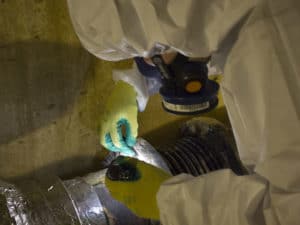What You Need to Know About Asbestos Management Plans & Managing Asbestos
An asbestos management plan is needed to comply with the legal obligation to manage asbestos within certain properties and buildings. This applies to anyone with a responsibility for maintenance and repairs within a building that may contain asbestos.
The duty to manage asbestos as included within the Control of Asbestos Regulations 2012, requires duty holders to have an effective plan showing how they will manage the risk from asbestos within the buildings they have a certain responsibility for. You are an asbestos duty holder if:
- You own the building or property
- You are responsible through a contract or tenancy agreement
- You have control of the building but no formal contract or agreement
- You are the owner or person responsible for maintenance and repairs in a multi-occupancy building

What buildings require an asbestos management plan?
All non-domestic buildings and structures, no matter the business, must have their asbestos risk managed through an appropriate plan. Domestic property is not generally included; however, all common areas such as stairwells, lift shafts and roof voids must have asbestos management in place. In addition, should an organisation under contract be responsible for maintenance and repairs within domestic dwellings, then these will also fall under the duty to manage asbestos.
If you are not the duty holder of a property but have information about the building, you are legally required to co-operate with the duty holder. You must allow access to undertake inspections as required for the purposes of managing asbestos.
Why does the risk from asbestos need to be managed with a plan?
Asbestos in buildings is only a risk to health if asbestos fibres are released into the air and breathed in. Breathing in asbestos fibres can lead to many asbestos-related diseases. Workers who carry out repairs and maintenance to buildings are particularly at risk from asbestos.
Although it is now illegal to use asbestos in the construction or refurbishment of buildings, many thousands of tonnes were used historically, and vast amounts of asbestos-containing materials remain within buildings. Asbestos use in building was banned towards the end of 1999. Therefore, any building constructed or refurbished prior to the year 2000 may contain asbestos.
As long as asbestos-containing materials remain in a good and sealed condition without disturbance, the asbestos’ risk is negligible. However, should it become disturbed or damaged, especially during routine repairs or maintenance, it can become a danger to health. The only way to reduce the risk from asbestos is to manage asbestos within buildings effectively. Management of asbestos requires a written plan to ensure its effectiveness. This written plan is required by law and is called an asbestos management plan.
Whom does the asbestos management plan protect?
An asbestos management plan protects anyone undertaking any work of an intrusive nature in any building constructed or refurbished before the year 2000. In addition, anyone occupying the building during or after these works may also be at risk of asbestos is disturbed or damaged. Although the list of affected workers is extensive, the main people at risk from asbestos are:
- Construction and demolition contractors, roofers, electricians, painters and decorators, joiners, plumbers, gas fitters, plasterers, shopfitters, heating and ventilation engineers, and surveyors
- Anyone dealing with electronics, phone, and IT engineers and alarm installers
- General maintenance engineers and others who work on the fabric of a building
What are the main parts of an asbestos management plan?
The asbestos management plan is part of your legal duty to manage asbestos. The duty to manage asbestos in accordance with the Control of Asbestos Regulations 2012 requires the duty holder to manage the risk from asbestos. The risk from asbestos can be managed by:
- Finding out if there is asbestos on the premises or assessing if asbestos is liable to be present
- Presuming that materials contain asbestos unless you have strong evidence that they do not
- Finding out the location and condition of asbestos-containing materials
- Making and keeping up to date a record of the location and condition of asbestos-containing materials in your premises
- Assessing the risk from the asbestos-containing materials
- Preparing a plan that sets out in detail how you are going to manage the risk from asbestos
- Taking steps to put your asbestos management plan into action
- Reviewing and monitoring your asbestos management plan and the arrangements made to put it in place
- Making part of the asbestos management plan a system for providing information on the location and condition of asbestos materials to anyone liable to work on or disturb it
In readiness to prepare your asbestos management plan, anyone who has information regarding asbestos at the premises is required to make this available to you as the duty holder. You will need to assess the reliability of this asbestos information. All those that control access to the premises must co-operate with you in managing the asbestos risk.
What are the basic steps for creating an asbestos management plan?

Step 1: Find out if asbestos is likely to be present
Was the building built or refurbished before 2000? If no asbestos is unlikely to be present and no further action is required. If yes, assume asbestos is present.
You now need to do all that you reasonably can to find relevant information about the location inside and outside your building of asbestos-containing materials. Visually inspect the building and note potential asbestos-containing materials. Gather historical information, including plans and documents from architects, builders and consultants that may give useful information on the potential usage of asbestos-containing materials. You must always presume that materials contain asbestos unless there is strong evidence to suggest it does not. When you have gathered as much information regarding asbestos-containing materials as far as is reasonably practicable, move to step 2.
If you do not have any information or are unsure, not asbestos competent, then move straight to step 3.
Step 2: Assess the condition of asbestos-containing materials

If you have presumed asbestos materials that are in good condition and have no maintenance or repair work planned, move to step 4. If you have presumed asbestos materials or there is a likelihood of asbestos materials present, and you have maintenance or repair work in the future, go to step 3.
Remember if there is a likelihood of asbestos materials within the building and all materials are currently in good condition, then before any maintenance or repair work, you must go to step 3.
Step 3: Have an asbestos management survey undertaken
You must have a suitably trained person conduct an asbestos survey to identify asbestos-containing materials. This type of survey is called an asbestos management survey. During this survey, materials are sampled and analysed to prove if asbestos is present and its type.
It is recommended that you employ a suitably trained person/organisation to survey the premises and identify asbestos-containing materials. The survey should identify what asbestos materials are present, their location, extent, and condition.
You should ask the person/organisation if they are accredited and competent to carry out these survey works. The only available asbestos surveying accreditation in the UK is the United Kingdom Accreditation Service (UKAS) accreditation for asbestos surveying. This accreditation gives you the confidence that the person/organisation has been checked and audited independently to confirm they are competent and have adequate insurance.
The survey will assess the initial risk from the identified asbestos materials and contain recommendations on placing asbestos-containing materials into a safe and manageable condition.
Step 4: Compile a written record of the asbestos-containing materials
Now you must compile a written record of all findings. This written record must contain:
All asbestos materials identified, their location, extent, and condition
Roles and responsibilities for managing asbestos risk at the property
The record needs to be clear, concise, and easy to read. It must always be available at the premises for those that may need it. The record should have a clear plan showing the location of the asbestos-containing materials. The asbestos management survey will contain the bulk of the information required for you to prepare your record. It will show important items such as no access areas and presumed asbestos.
This written record forms part of your asbestos management plan. The asbestos management plan will only manage the risk from asbestos with this information present.
Step 5: Use the written record from the asbestos management plan
Now that you have your written records, you must compile the plan that you will be using to manage the risk from asbestos-containing materials at the property. You must then act on your plan. The asbestos management plan must include but are not limited to:
- Details of duty holders asbestos training.
- Details of how you will pass on your asbestos register to those that may need it.
- Risk assessments of the asbestos-containing materials. These must be priority risk assessments. The material risk assessments from the asbestos management survey are not sufficient. They will not consider the building’s use and occupancy and how likely the asbestos materials are to be disturbed or damaged. Priority risk assessments are in addition to the risk assessments contained within the survey. Priority risk assessments are detailed within the additional information pages on the Oracle website.
- High priority ratings and plans for managing risk from damaged asbestos materials or asbestos materials likely to be disturbed.
- An asbestos action plan including timescales on required asbestos remediation work if needed. If asbestos will potentially be disturbed and cannot be protected or enclosed, it must be removed by a specialist contractor.
- How will the risk from damaged asbestos be controlled until the required works are carried out?
- Details of trained personnel and specialist asbestos contractors for work on or near asbestos-containing materials
- Details of required employee asbestos training as required by the regulations. (Asbestos Awareness)
- Procedures to follow if there is an asbestos emergency or uncontrolled disturbance
- Details of how asbestos materials location and safe working will be given to general occupants of the building. i.e., labeling of asbestos-containing materials.
- Details of steps to be undertaken to manage asbestos risk from refurbishment and demolition work. i.e., asbestos refurbishment and demolition surveys.
- The asbestos management plan sections will vary from building to building and be dependant upon what the property is being utilised for, what the occupancy is, and what asbestos-containing materials have been identified. If you are unsure, speak to a member of the Oracle team for expert advice.
Step 6: Keep your asbestos management plan and records up to date
It is a legal requirement to keep your asbestos management plan and records up-to-date to ensure they are being acted upon, followed, and are effective at managing the asbestos risk within your property. The following are required to keep your records and plan in date and legally compliant:
- Annually audit all records and the asbestos management plan to ensure it is working. Review any uncontrolled asbestos disturbance or damage and check to see if the plan could be amended to reduce this risk in the future. Check all records to ensure all asbestos-related work has been recorded and is accurate.
- As a minimum, annually reinspect all asbestos-containing materials at the property and update the asbestos survey report/register appropriately with any changes in condition.
- Should annual re-inspections or audits highlight potential uncontrolled asbestos risks, then the plan must be updated to reduce these risks, and the plan must be acted upon.
How can Oracle help with my asbestos management plan?
Oracle Solutions provide a full and detailed asbestos management service, including the compilation of asbestos management plans. During this process, Oracle will help you compile your asbestos priority risk assessment and put an asbestos action plan together to ensure your legal compliance with current asbestos regulations.
In addition to our asbestos management and management plan services, Oracle also provides the following services:
